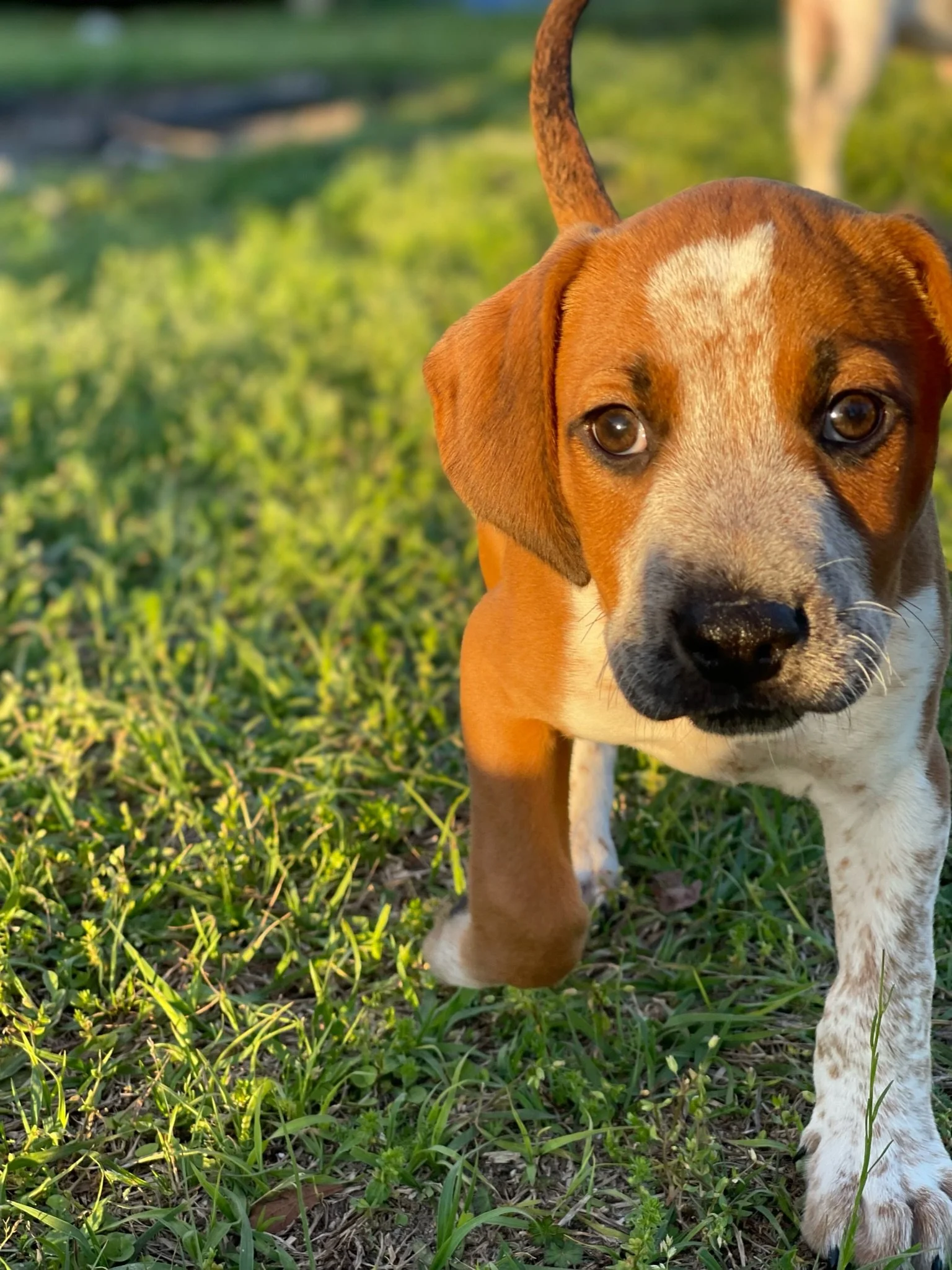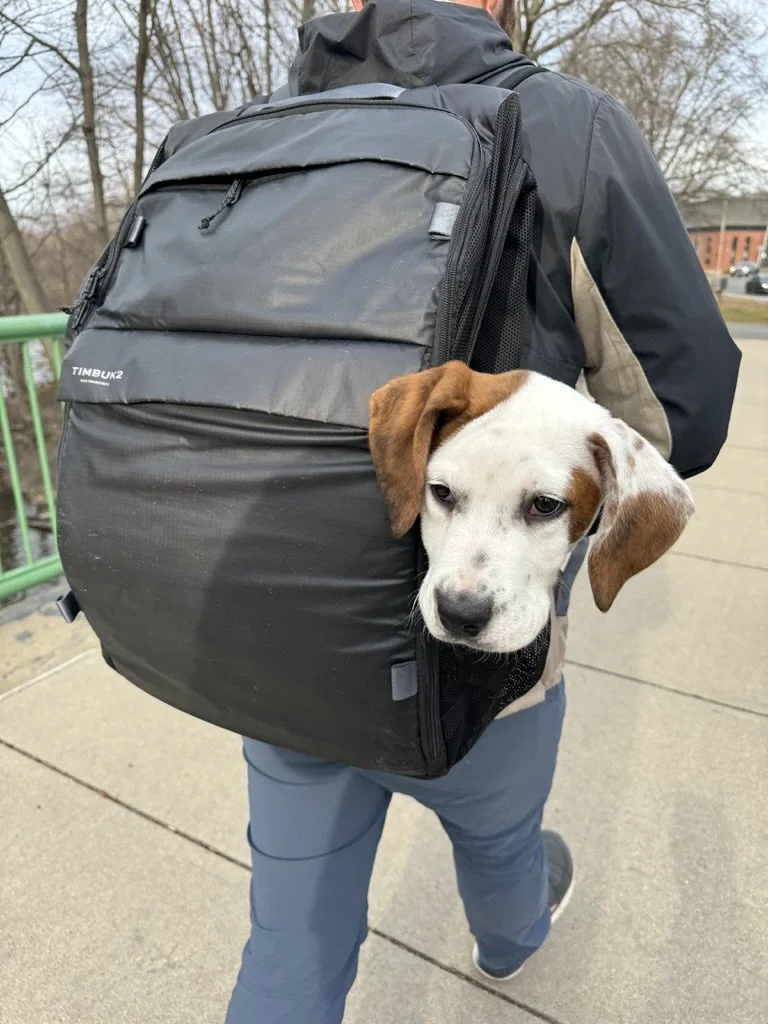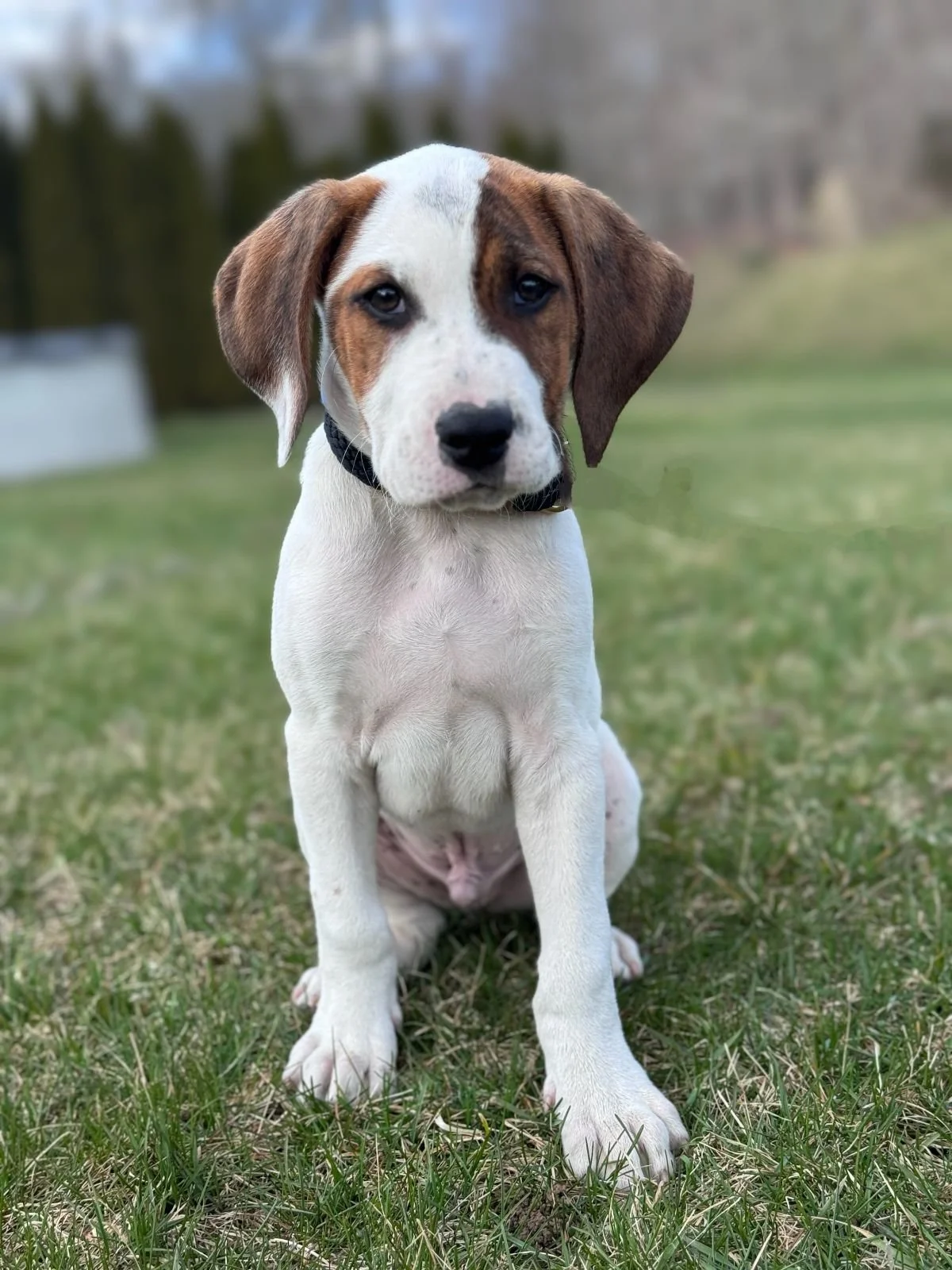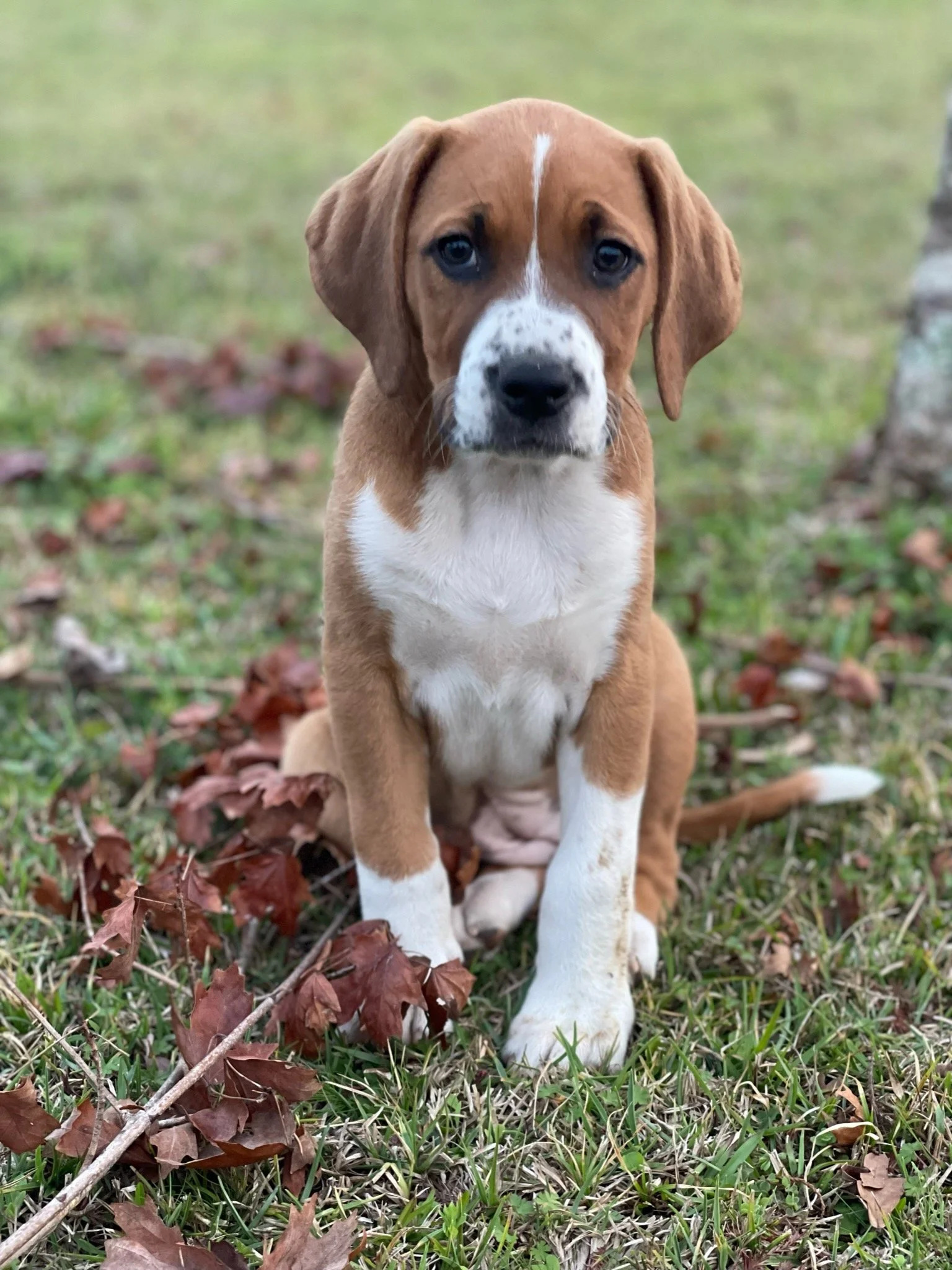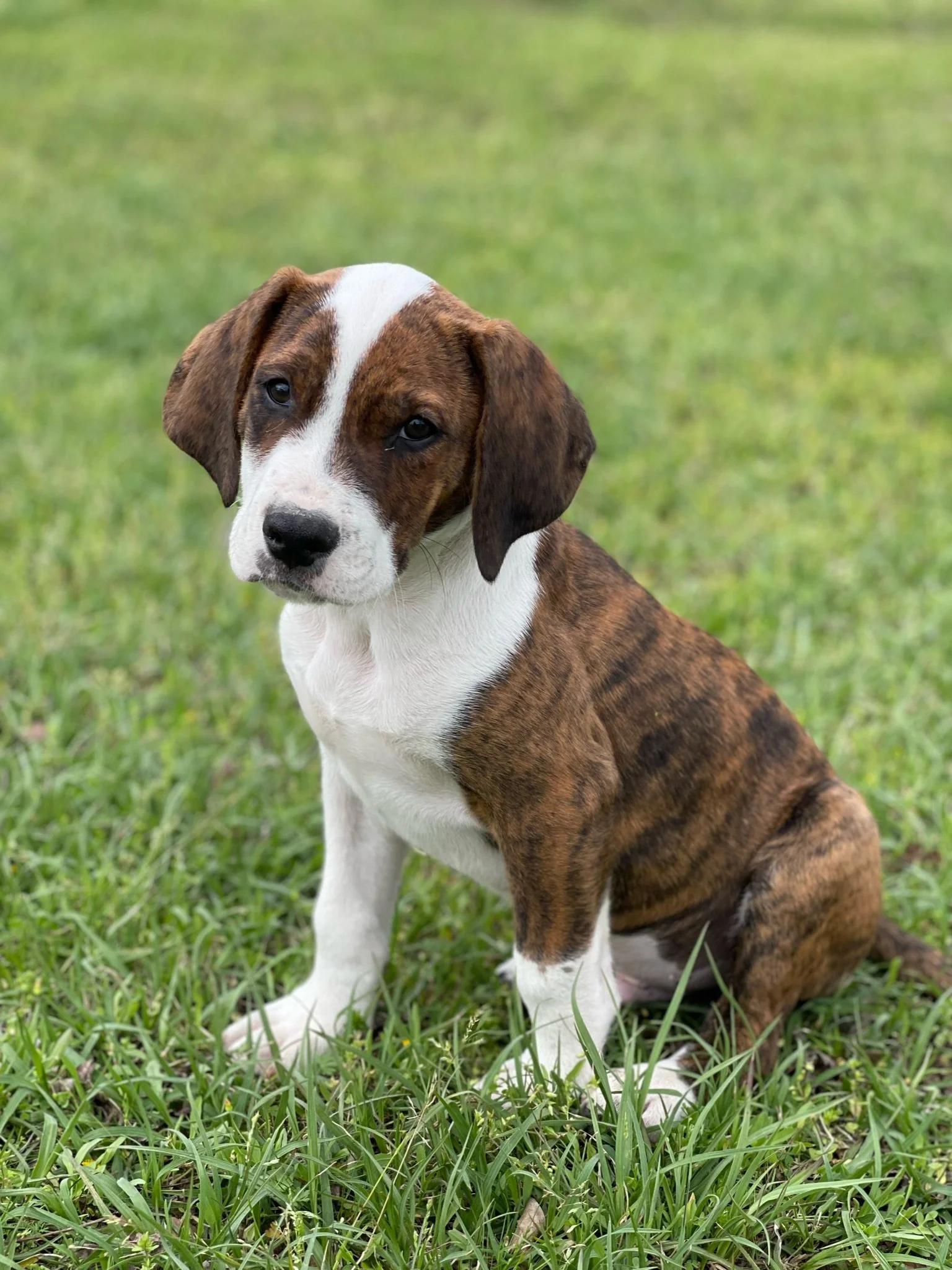Harry Potter Hounds - ADOPTED
Meet the Puppies
These TEN (!) puppies were pulled from a hoarding situation, along with their Mama. Their Mama, the delightful Professor Minerva McGonagall (Min for short), is an amazing 60lb coonhound. She’ll be staying in the South for extended fostering to get medical treatment for heartworm disease (not transferrable to puppies). She is an amazing Mom to her puppies, and she has a wonderful, human-loving, loud, playful personality. She is the definition of a coonhound, operating at 0 or 100, full of loud love for anyone willing to give her attention.
Her ten kids are the typical rambunctious, funny, cuddly, dramatic, curious, trouble-making pups. When they were rescued at approximately 3-4 weeks of age, they were still actively feeding off their Mama. Their sizes ranged from 1-5lbs, from teeny tiny to chunker. They have weaned off naturally, have started wet and dry food, and have continued to thrive in our fosters’ care. They are just starting crate training, and we expect their adopters to continue crate training to ensure they get their much-needed puppy snoozes and keep them out of danger of chewing up objects! After all, sometimes a puppy just needs to go to their “room.” With continued love, patience, structure, boundaries, and PROFESSIONAL training, these pups will all be fantastic canine companions.
Temperament
Our best guess is that these puppies are coonhound mixes of some sort. Mixed with what, who knows?! Coonhounds are always equal parts active and lazy. They will give it their all on a hike, but also sunbathe for hours without a care in the world. Coonhounds are also equal parts smart and stubborn, so anyone who. knows a coonhound knows that boundaries and professional training escalates them from being a good dog with “selective hearing” to a reliable, fantastic dog!
These dogs are NOT for those looking for a couch companion or a single-walk-a-day type of dog. These happy, curious puppies are ready for exposure to new life experiences. They are all well mannered, some are more quiet and shy, while others more outgoing and fiesty.
Bonus, all of these pups are being fostered in kid-based homes (ranging in 1-10 years old). Four of these pups even went on a show-and-tell adventure to the elementary school, and thrived with all the attention and love they got from teachers and students.
With continued proper socialization and professional training (A MUST), they will be great family members. Given their breed guess, these pups are not yard dogs, and those adopting should expect regular long walks, mentally stimulating activities or games, fun adventures, and lots activity. More personality details below.
Needs
These puppies are startng their crate training, and you should anticipate a bit of a “restart” when they move in. Given their breed type, they will probably benefit from the crate as a lifelong tool. The crate works as a great “off-switch” for any puppy, and teaches them to balance energy and calmness.
These puppies NEED a back yard, this breed is not well suited for city small living. They don’t need a huge yard, but they need to be able to burn some of that energy and do some sniffing outside during their short potty breaks in addition to their walks! Traditional fencing is NOT required.
These puppies would love dog siblings or friends. They love to play, and do very well with senior dogs correcting them.
These puppies will be best suited to an to a an active family or couple, willing to give them regular walks and playtime, and when age appropriate, runs, and trails adventures. They should continue socialization with other dogs through puppy play dates.
Adopters should be ready to start PROFESSIONAL training with one of our recommended trainers around six-nine months old to continue proper dog socialization, work on nice leash manners, and heel-side walking, structured walking, place command, and prepare for off-leash remote collar fun.
Those with balanced training experience, and slip lead/prong/remote collar experience are preferred but not at all required!
As an organization, we prefer balanced training over positive only, which is balanced between positive rewards, but also rules and structure to set boundaries. We are firm believers that the more rules you have for your dog when they are young, the more freedom they earn as they get older. So set down expectations and boundaries for your dog now with a trainer and the right tools, so they can be part of all the family fun!
Those who don’t believe in rules, routine, and structure for your dog, need not apply.
PLEASE KEEP IN MIND, we will only consider applicants where one adult has a more flexible schedule, as puppies are a lot of work, and will require potty breaks, exercise, training and continued human and dog socialization as they grow up.
Vetting
All dogs rescued by FAVOR are:
Spayed/Neutered
Microchipped
Vaccinated for Rabies*, Bortedella (kennel cough), DA2PL (distemper, adenovirus, parainfluenza, leptospirosis and parvovirus)
Up-to-Date on Flea/Tick Topical Preventative
Up-to-Date on Heartworm Preventative
Dewormed
Rabies must be administered after 12 weeks of age. If puppies travel before 12 weeks, Operation Favor will refund adopters $15 towards the cost of their rabies shot. These puppies will be traveling before 12 weeks, a $15 refund will be transferred upon proof of rabies!
Adopters immediate responsibility will include:
Required: Puppies WILL require DA2PL 3rd booster shots when age appropriate (between 14-18 weeks of age) at the expense of the adopter
Optional: LYME-LEPTO combination vaccine at the expense of the adopter
Cost
$650 Adoption Fee PER DOG
NEW ENGLAND Arrival Date
IN NEW ENGLAND - We offer foster-to-adopt, so please read our FAQs for more information!
Crate/Potty Training
All puppies and dogs rescued by FAVOR are crate trained, sleeping in the crate from 8pm-6am (with a potty break around 11pm), and accustomed to some day crate time as well. Puppies also understand the basic concept of peeing outside, but there is ALWAYS a transition period where crate cries and potty accidents WILL HAPPEN in a new home, as the dog transitions to new rules and ways to communicate.
We always recommend keeping dogs crated during nap times, bed time, and when they are alone to protect them from danger such as chewing on cords, socks, and other objects. Foreign objects can get stuck in their stomachs which can result in a very expensive surgery. We also encourage using the crate like a bedroom for your dogs as they get older, where they can take naps, take a break from human interaction, and have a time out. More importantly, the crate provides them a safe place to go to when things get overwhelming, like a lot of people, loud noises, extreme weather. Think of the crate as their “den,” and a place for them to unwind. We all need a break sometimes! Here’s a typical puppy schedule, written by our partner trainers, to get you started!
Still have questions?
Please read our FAQs if you have any questions on our organization. Many common questions can be answered here.
Dobby - ADOPTED
Age at Arrival: 17-18 weeks
DOB: Christmas-ish
Current Weight: 15lbs
Approx Full-Grown Weight: 40-70lbs
Gender: Male
Breed: Coonhound/Beagle/Boxer/ABPT
Temperament: Dobby is the cry baby of the group. He’s not afraid of the world, he just makes noise when he doesn’t get his way with his siblings or when he’s unsure of what is expected of him. Oh the horror! Dobby could use some with experience will not become victim to his pathetic cries, and will be a true pack leader for this chatty Cathy! Dobby will arrive mid to late April!
Training is a must for these pups!
Kid Tested: Kids 1+
Cat Tested: Yes
Dog Tested: Yes
Confidence: Low
Draco - ADOPTED
Age at Arrival: 17-18 weeks
DOB: Christmas-ish
Current Weight: 15lbs
Approx Full-Grown Weight: 40-70lbs
Gender: Male
Breed: Coonhound/Beagle/Boxer/ABPT
Temperament: Don’t let his “Slytherin” wizard convince you he is evil. Draco is a super special, sensitive soul. He takes a second to observe new situations, but then welcomes all the cuddles, scratches, puppy playtime he can find! He’s a little more dramatic than his counterparts, but his drama is short-lived, and he bounces right back to play! Draco will arrive mid to late April!
Training is a must for these pups!
Kid Tested: Kids 1+
Cat Tested: Yes
Dog Tested: Yes
Dog Tested: Yes
Confidence: Middle
Harry - ADOPTED
Age at Arrival: 10-11 weeks
DOB: Christmas-ish
Current Weight: 11lbs
Approx Full-Grown Weight: 40-70lbs
Gender: Male
Breed: Coonhound/Beagle/Boxer/ABPT
Temperament: The smallest of the bunch, Harry was a mere 1.5lbs when we found him, smooshed amongst his siblings. He’s still the smallest, but much like his the character he is named after, he is a feisty, resilient, trouble-maker. He loves to cause chaos and beat up on his siblings or his foster family canines. He’ll do great in any household, but he will certainly keep you on your toes. He could use a Professor Snape in his life to keep him in check.
Training is a must for these pups!
Kid Tested: Kids 1+
Cat Tested: Yes
Dog Tested: Yes
Confidence: Middle
Hermione - ADOPTED
Age at Arrival: 10-11 weeks
DOB: Christmas-ish
Current Weight: 14lbs
Approx Full-Grown Weight: 40-70lbs
Gender: Female
Breed: Coonhound/Beagle/Boxer/ABPT
Temperament: Hermione is a curious and confident explorer. She’s got a natural, easy going quality about her which makes it easy to forget she exists amongst her 9 louder siblings. What makes her special is that she is happy to play with siblings or other dogs, but also happy to be independent. Much like her characters name, she has no problem marching to the beat of her own drum and doesn’t take offense if not one wants to hang with her.
Training is a must for these pups!
Kid Tested: Kids 1+
Cat Tested: Yes
Dog Tested: Yes
Confidence: High
Neville - ADOPTED
Age at Arrival: 10-11 weeks
DOB: Christmas-ish
Current Weight: 15lbs
Approx Full-Grown Weight: 40-70lbs
Gender: Male
Breed: Coonhound/Beagle/Boxer/ABPT
Temperament: Neville is a typical sweet and playful pup. We hate to use the word “typical,” but Neville has grown up before our eyes to be a truly balanced pup. He was a whiny pup amongst his siblings, but with some time away from his siblings he has grown into an easy going, obedient, well-rounded dog. He’s a rule follower and a people pleaser, and would love to be your shadow!
Training is a must for these pups!
Kid Tested: Kids 1+
Cat Tested: Yes
Dog Tested: Yes
Confidence: Middle
Ron - ADOPTED
Age at Arrival: 10-11 weeks
DOB: Christmas-ish
Current Weight: 15lbs
Approx Full-Grown Weight: 40-70lbs
Gender: Male
Breed: Coonhound/Beagle/Boxer/ABPT
Temperament: The cuddliest and most affectionate lump of potaties of the group, Ron just wants all the love. He’s a giant pile of mush. He’s a shadow to the humans, but also curious and quietly confident. He causes chaos with his siblings, but solo, he’d just like to live in your lap. He does have an occasionaly noisy side, probably for those time his belly isn’t being rubbed.
Training is a must for these pups!
Kid Tested: Kids 1+
Cat Tested: Yes
Dog Tested: Yes
Confidence: Middle
Luna Lovegood - ADOPTED
Age at Arrival: 10-11 weeks
DOB: Christmas-ish
Current Weight: 14lbs
Approx Full-Grown Weight: 40-70lbs
Gender: Female
Breed: Coonhound/Beagle/Boxer/ABPT
Temperament: If you are looking for confidence and mischief, Luna Lovegood is your gal. She’s sweet and spunky, with an outgoing, go-with-her-own-flow personality! She’s a definite leader of the group, and likes to cause trouble. A perfect Luna Lovegood quote that matches this gal’s personality… “YOU’RE JUST AS SANE AS I AM.”
Training is a must for these pups!
Kid Tested: Kids 1+
Cat Tested: Yes
Dog Tested: Yes
Confidence: High
Hagrid - ADOPTED
Age at Arrival: 10-11 weeks
DOB: Christmas-ish
Current Weight: 13lbs
Approx Full-Grown Weight: 40-70lbs
Gender: Male
Breed: Coonhound/Beagle/Boxer/ABPT
Temperament: One of the tallest of his litter, which fits his name, this guy is confident around his siblings and other canine friends, but shy around people. We are working on building his confidence, but this guy would do great with a canine sibling to show him the ropes.
Training is a must for these pups!
Kid Tested: Kids 1+
Cat Tested: Yes
Dog Tested: Yes
Confidence: Middle
Ginny - ADOPTED
Age at Arrival: 10-11 weeks
DOB: Christmas-ish
Current Weight: 15lbs
Approx Full-Grown Weight: 40-70lbs
Gender: Female
Breed: Coonhound/Beagle/Boxer/ABPT
Temperament: If Ginny was a boy, she would have been named Dobby. Between the look and her personality, she is very much a sweet, sensitive, scrappy soul. She also LOVES other dogs and humans, and wishes she could love in a constant cuddle puddle. We’d love to see her with a confident sibling to snuggle with her, and teach her that the world is not a scary place!
Training is a must for these pups!
Kid Tested: Kids 1+
Cat Tested: Yes
Dog Tested: Yes
Confidence: TBD
Sirius Black - ADOPTED
Age at Arrival: 10-11 weeks
DOB: Christmas-ish
Current Weight: 12lbs
Approx Full-Grown Weight: 40-70lbs
Gender: Male
Breed: Coonhound/Beagle/Boxer/ABPT
Temperament: While his siblings have more of a rich orange/copper color, Sirius Black is more of a brindle pup. He’s both confident and mischievous. He spends much of his time keeping his brother Harry in check, but he’s very subtle about the lessons he has to teach Harry! He’s super affectionate and the most obedient of the bunch, and stops in his tracks at the word, “No.”
Training is a must for these pups!
Kid Tested: Kids 1+
Cat Tested: Yes
Dog Tested: Yes
Confidence: High


